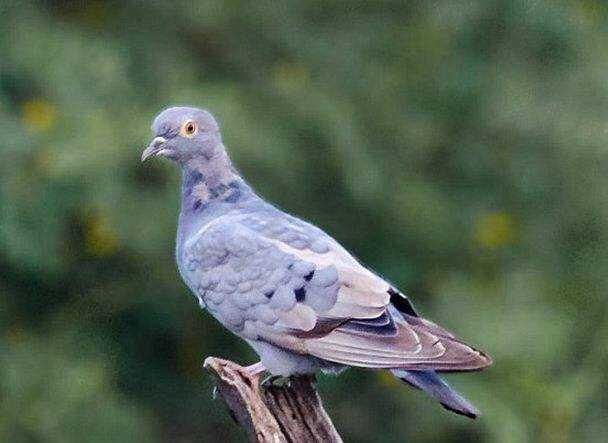Pale-backed Pigeon
IUCN
LCBasic Information
Scientific classification
- name:Pale-backed Pigeon
- Scientific Name:Pale-backed Pigeon,Columba eversmanni
- Outline:Landfowl
- Family:P.Order P. family P.genus
Vital signs
- length:26-30cm
- Weight:183-284g
- lifetime:About 16 years
Feature
It resembles a European dove, but has a white back
Distribution and Habitat
It is distributed in Afghanistan, China, India, Iran (Islamic Republic of), Kazakhstan, Pakistan, Tajikistan, Turkmenistan and Uzbekistan.
Kashgar and Tianshan Mountains in Xinjiang, China, also found in the northern Altai Mountains; It is occasionally found in Lop Nur, eastern Xinjiang. Winter roams into the mountains and plains near breeding grounds, as far south as Afghanistan and northern India.
It inhabits rocky and overhanging areas in deserts, mountain plains, and forests, especially in forest cliffs along river valleys.
Appearance
Male and female plumage are similar in Central Asian pigeon. The top of the head is gray and stained with wine. Eye first, cheek, ear cover, chin and throat dove gray. The hindneck and shoulders are grey with a green and purplish red sheen. There is a prominent light copper red patch on each side of the neck; The back and shoulders are gray, the underback is white, the waist and tail are covered with SLATE gray, and the feather margin is darker brown. The tail feathers are mostly gray, with broad black tip spots; The lateral tail feathers are also perforated with light gray stripes; The upper cover feathers are mostly pigeon gray, the base of the middle cover feathers and the large cover feathers are black, and two black stripes are formed on the wings. The primary and secondary fly feathers are gray, the inner base of the first primary fly feather is white, and the inner secondary fly feathers are the same color as the back. But the feather base has a broad black stripes; Pigeon grey
Details
The Central Asian Pigeon is known as Pale-backed Pigeon and has no subspecies.

Central Asian pigeons Often live alone or in pairs. Occasionally in small groups, sexually active, fast and powerful flight. It mainly feeds on berries, figs and other plant fruits and seeds, and also eats crop seeds. It often forages in secondary forests and forest margins. Sometimes they also forage for food in agricultural fields and rice paddies outside the forest. It mainly feeds on the fruits and seeds of various plants, but also eats crops such as mulberry and corn.
The breeding period of Central Asian pigeons is from April to July. Nest in tree holes, abandoned animal burrows, abandoned buildings and wall holes. They also nest in cave walls. The nest has no internal bedding. Each clutch lays 2 eggs. The egg is white in color. The size of the eggs is 33.2-38.1×25.7-28 mm. Male and female birds incubate their eggs in turn.
During brooding period, pigeon milk is secreted under the action of prolactin (also known as prolactin) secreted by the posterior pituitary gland. Pigeon milk is composed of fat-filled granules, emulsified chylous fluid and lymph fluid exfoliated from the swollen flat epithelium in the lymphatic area of the bilateral lateral capsule of female and male pigeons, namely, the crop bed. After the colostrum stage, chylous fluid rich in emulsified fat particles is gradually added. In general, on the 4th to 5th day of incubation, the male and female pigeons' crop beds began to sprouted, and the blood vessels of the crop beds were congested, thickened, and lymphatic vessels hyperplasia. On the 8th to 9th day, the crop epithelium thickened and entered the pre-brooding state. On the 13th day, the thickness and width of the pigeon had doubled, transparent yellowish milk could be secreted on the 14th to 16th day, the crop could secrete the throat milk on the 18th day, but on the 7th day after the squabs emerged from the shell, the secretion of the crop milk began to decrease, and on the 10th day, the secretion stopped, and the squabs continued to retching until about 2 weeks of age, the crop bed began to shrink, and the milk secretion gradually ceased. The chymous pulp is gradually mixed into the semi-finished chymous pulp which is backflowed from the glandular stomach and ground through the muscle stomach, and then it is changed into the granule feed which is directly fed with water. If the hatched eggs fail to shell on time, the broody pigeons can continue to hatch until the 22nd to 24th day at most (these are related to the hatchability of the pigeons, the incubation season and the information feedback of embryonic development, the frequency of breaking the shell of the foetus, etc., such as in the cold winter and spring and the brooding period, the incubation period is often automatically extended, and it is often difficult to persist in the hot and hot days). At this time, the brood will automatically stop brooding with the shrinkage of the crop bed.
The Central Asian pigeon is a summer migratory bird, which is only found in Xinjiang in China, and its number is rare, so attention should be paid to protection. This species has been declining rapidly in the past, probably as a result of agricultural occupation and hunting in its wintering grounds, and possibly habitat loss in its breeding grounds, and this decline is expected to continue. These factors define its fragile state of existence.
It was included in the List of Beneficial Terrestrial Wildlife under State Protection or of Important economic and scientific research Value issued by the State Forestry Administration of China on August 1, 2000.
Listed in China's "three protected animals" list.
Listed on the International Union for Conservation of Nature (IUCN) 2013 Red List of Threatened Species ver3.1 - Vulnerable (VU).
It is listed in the second level of the List of China's National Key Protected Wildlife.
Protect wild animals and eliminate wild meat.
Maintaining ecological balance is everyone's responsibility!








